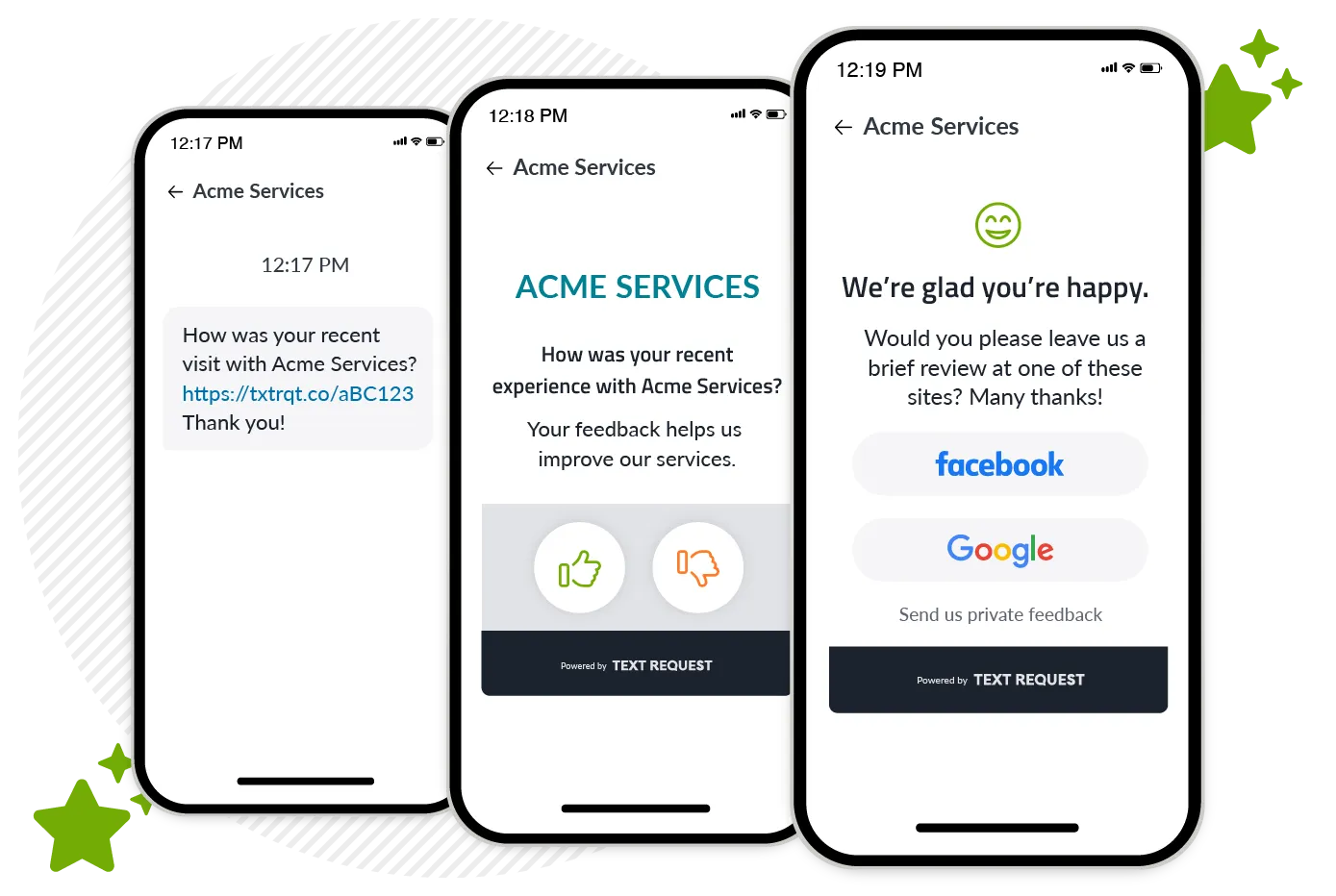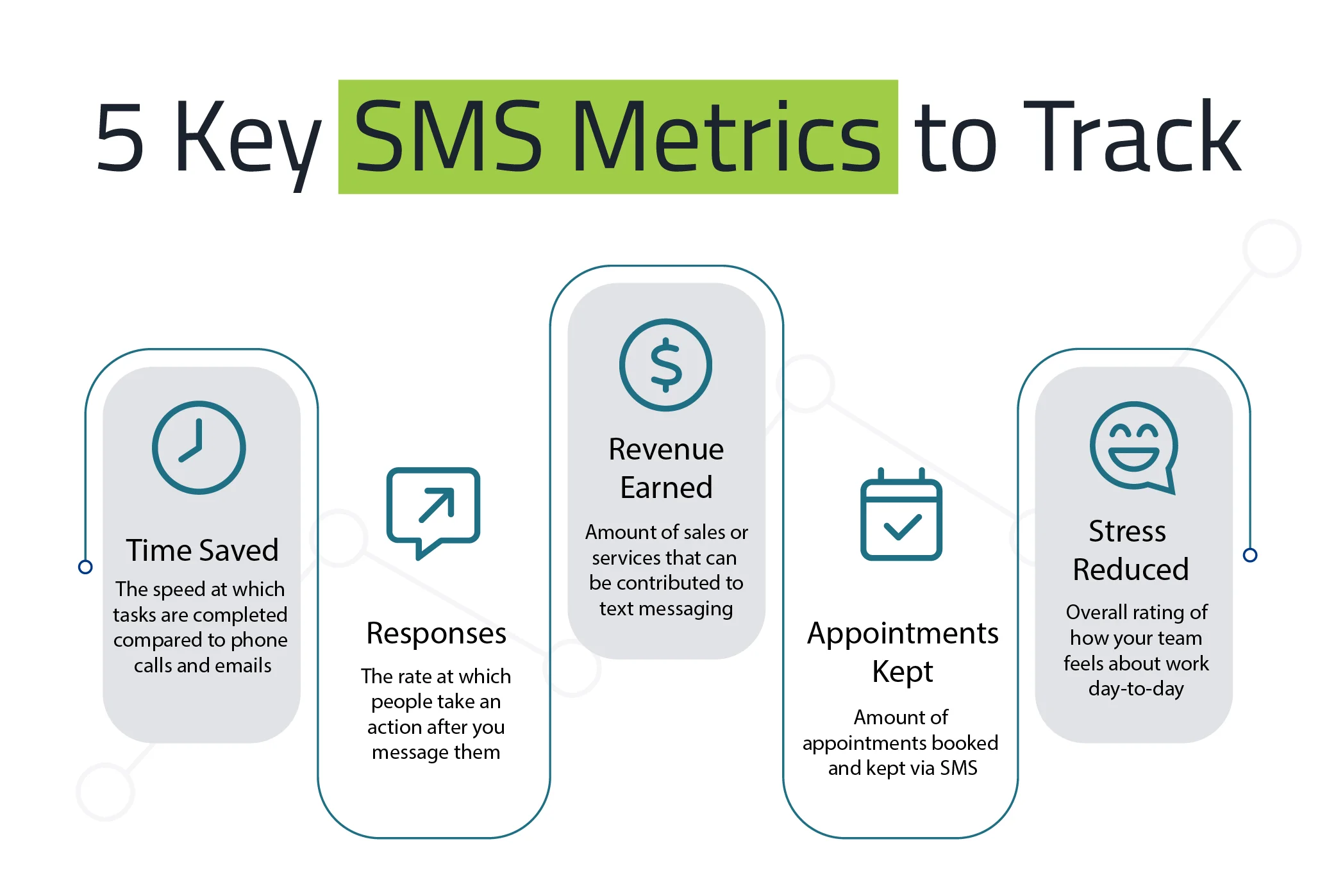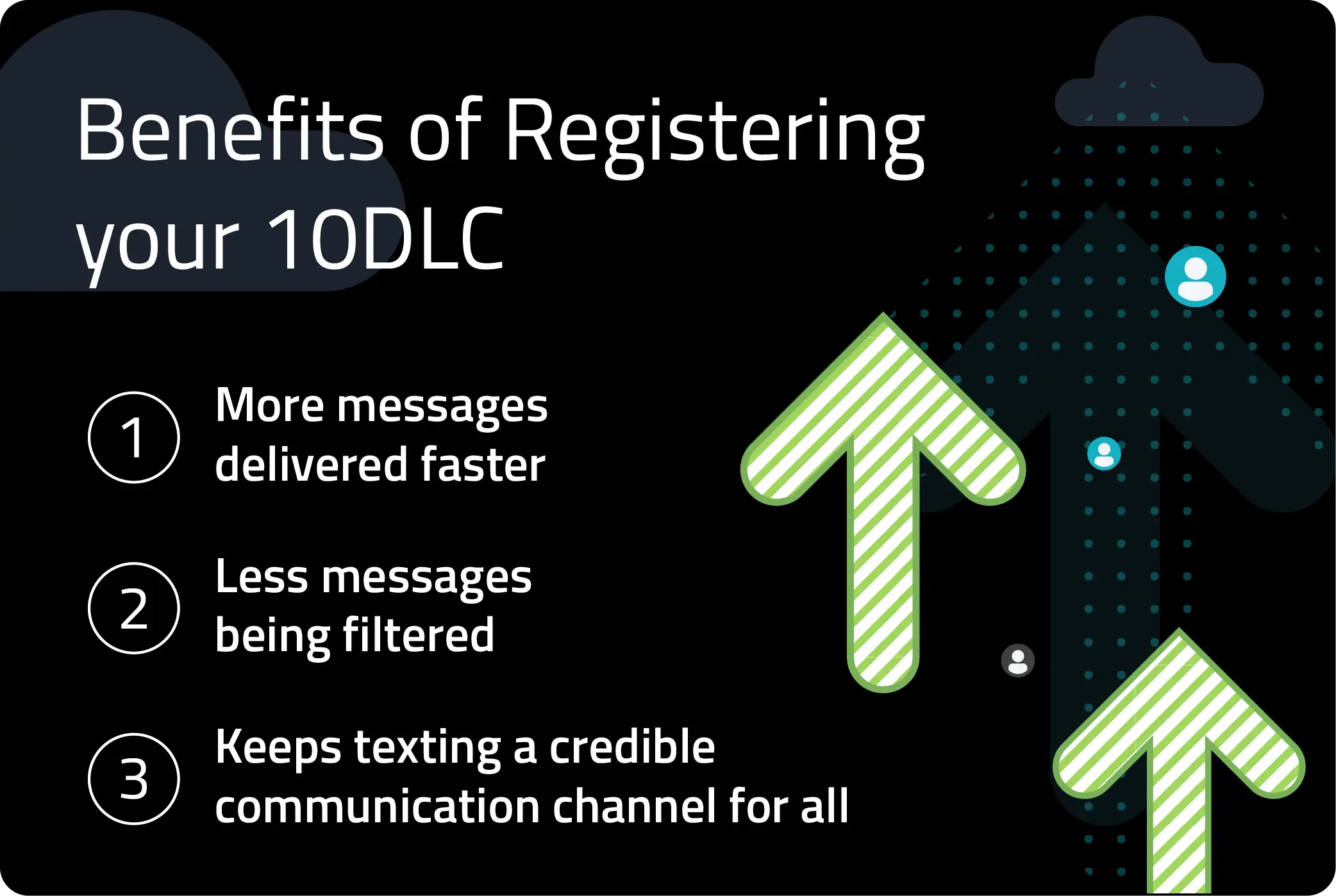Report
2024 State of Business Texting Report
We live and breathe business text messaging every day. We’re guessing you don’t, so we created this report to show you what’s happening, why it matters (if it matters at all), and what you can do about it.
The main questions we’re trying to answer in our 2024 State of Business Texting Report are:
What’s happening in the market today?
Where are things heading in the next 12 months?
What are the biggest opportunities and challenges?
So we surveyed professionals across all ages and industries, and gathered some interesting data that will help you run a more profitable business, create better customer experiences, and make employees’ lives easier. It’s also helpful for nonprofits and other organizations.
Let’s get to it.
What is business texting?
Business texting is sending and receiving texts professionally as an organization, typically through your office phone number, and typically using a service like Text Request. This is what we have in mind as we talk about the survey data and insights below. For more details, view our Complete Guide to Business Texting.
What are the main benefits of texting as a business?
A business isn’t going to do anything new without it adding value or solving a problem. According to respondents, these are the top benefits of business texting:
1. Stop Repeating Tasks
People typically do not answer phone calls and may miss your email, but a text message is seen and answered almost instantly. By texting, you don’t have to repeatedly call and email to get a response.
2. Get 2x as Much Done
Save a ton of time by texting en masse instead of calling customers and employees individually. There’s no need to hire more people to handle higher volumes (or your current volume).
3. Fill the Gaps
Faster, more effective communications keep both customers and employees in the loop, so no one misses a beat. The end result is a smoother experience for everyone, and higher profits for your organization.
Other notable benefits are shared below.
Highlights: Top 3 Takeaways for 2024
1. Top Use Case: Customer Service
75% of businesses who text, text for customer service. (The second most common use case is for appointment scheduling, at 68%. We’ll come back to that later.)
“Customer Service” does tend to be a catch-all category for customer conversations that may not fit clearly in other categories, like customer check-ins, support, and any number of customer questions that come up day-to-day. Still, this underscores two important observations:
Consumers increasingly expect text messaging (SMS) as a standard channel for business communications
Once consumers understand texting is an option, they tend to default to texting instead of using other channels
This is true for nonprofit, business-to-business (B2B), business-to-consumer (B2C), and even government organizations. People expect texting, and the organizations meeting those expectations are winning. Those who don’t will miss out.
Recommendation: Replace everyday customer calls with text messaging. Some of those conversations may end as phone calls, but you’ll save hours of time a week while creating better customer experiences and minimizing small talk.
2. Top Opportunity: Collecting Online Reviews and Feedback
Online reviews on platforms like Google and others help you rank higher in search results, show potential buyers how great you are to work with, and generate more business. Private feedback is also valuable for internal improvements that directly affect customers and your bottom line.
Most professionals understand this, and yet only 21% of organizations report texting for online reviews and feedback. That’s a massive (missed) opportunity.
We also asked everyone what else they wished their organization was texting for, if anything. The #1 response was for reviews and feedback (35%).
Collecting online reviews and feedback is something that’s critical for business growth, that most aren’t doing but wish they were, and that we know is an effective use of business texting. It’s also rather easy to do. This is your best opportunity and easiest way to improve in 2024.
Recommendation: After working with a customer, client, or patient, send them a “thank you” text that includes a link to your review page, and ask them to share their experience. View our Ultimate Guide to Reviews for more details.
3. Top Challenge: Tracking and Proving ROI
Virtually everyone we asked could tell you how much time they save (or don’t) by texting. Meanwhile, 62% couldn’t tell you what their return on investment (ROI) of texting is.
We wouldn’t expect everyone to know the exact figure, but we thought most would have an idea of what they’re getting in return. That’s not the case. Tracking ROI was also a major challenge shared in our 2023 State of Business Texting Report.
Tracking ROI seems to be an issue that extends beyond texting, but—sticking to text messaging—we see three common issues here:
Managers and owners do not always explain or show the value of what they’re asking employees to do
Managers and owners may not be attributing dollars made or saved to specific tools and tactics
Some respondents consider ROI only in terms of net new revenue, but primarily text to save time and aren’t calculating how much their time is worth
Recommendation: Choose one or two metrics to monitor (suggestions in the image below), and begin tracking them or comparing them to what you did before. Then communicate those metrics to your employees. “That which gets measured gets improved.” This will help you improve while aligning employees around a common goal.
3 More Important Findings
1. Everyone would be happier if appointment scheduling and reminders happened entirely through text.
There probably are some people who prefer to make a call to schedule an appointment, or who prefer to receive a personal phone call reminding them of their appointment, but the data makes a compelling case to replace those calls with texts.
68% of businesses text for appointment scheduling already
74% of businesses who aren’t texting for appointments wish they were
77% of consumers want to initiate texts to businesses about scheduling an appointment
87% of consumers want to receive SMS scheduling notifications from businesses
Texting for scheduling is effective, consumers want it, and—as we’ll cover in point 3 below—it will help your employees save an impactful amount of time.
2. Texting may be your best sales asset.
Per The Radicati Group, the go-to source for email volume statistics, the average email account gets 78 emails per day. Email open rates vary widely—Mailchimp shows an average open rate of 21% while Constant Contact shows 34%.
Anecdotally, most adults have at least two email accounts (one work, one personal), and they’re getting 78 emails a day on each. That’s a lot of messages to get, most of which go unopened. Texting has much higher engagement, and much less competition.
66% of people get fewer than 20 texts per day
74% of people read every text they get
62% of people read and respond to those texts within a few minutes
If you need to get someone’s attention for a sales follow-up or promotional message, text is a good option. You’ll be able to stand out and get the recipient to act quickly. You may even want to use email and text together, rather than just one channel.
3. Save 10+ hours a week.
We asked respondents how much time they save by texting in place of calling or emailing, if any. 35% said they save two-to-five hours a week, another 31% said they save one-to-two hours a week, and 10% said they save 10+ hours a week.
10 hours a week is substantial! So we followed up with these respondents and asked what they were doing to save that kind of time. Even across industries and roles, the answers were similar:
Replacing individual calls with mass texting to reach everyone within a few moments
Avoiding delays in work or projects by texting individual customers and employees—and getting near-instant responses—instead of calling or emailing and waiting for a response
Cutting out small talk with customers—it adds up
It was also common for respondents to say that they can now “get twice as much done” by replacing other communications with text messaging, and could even forgo hiring new employees because they save so much time by texting.
To be clear, this does not represent the majority of respondents or a generalization of the market at large, but it’s a notable percentage. Consider replacing repetitive calls, customer updates, and employee check-ins with texts.
3 Predictions for Business Texting in 2024
1. Texting for online reviews will become commonplace.
Texting for online reviews is the biggest and possibly most profitable opportunity we’ve found in this year’s survey. Opportunities like that don’t stay hidden for long, so we expect this to become commonplace quickly.
Review management software has become increasingly prevalent over the last few years, anyway, and text messaging is a natural extension of that, which customers and businesses will both benefit from.
2. Regulations are going to get stricter.
Our survey did not ask about regulations, yet we expect this to be part of nearly every business texting conversation in 2024. Mobile carriers and governing bodies are increasingly scrutinizing which organizations are texting, for what purposes, and whether it’s legitimate or spam.
This will ultimately create better, more trusted experiences for everyone involved, but there are three clear takeaways for you now:
You’ll need to register your business and earn approval before texting.
This will be true for texting through both toll-free and 10DLC (10-digit long code) numbers. This will affect how quickly you can get up and running once you’ve decided to text.
You’ll need to prove that contacts opted into messages.
That means you can’t just buy a list of contacts or text for cold outreach. There needs to be an established commercial relationship, preferably one where the contact explicitly opted into messages or granted permission for you to text them.
Organizations who act sooner will have an advantage.
Organizations who get registered sooner and build a strong sender reputation earlier will likely be able to do more or move faster than those who wait. If you’re considering business texting, best to start ASAP.
For more details, view our Complete Guide to 10DLC regulations.
3. Texting will soon become the default for most businesses, overtaking phone calls and maybe even email.
This is already happening in some organizations (our 10% of survey respondents who are saving 10+ hours a week, for reference). We expect this to happen more and more.
It won’t apply to everyone, of course, but we expect those organizations who spend large chunks of their days trying to communicate with customers and employees on the phone to shift largely—if not entirely—to text messaging.
Methodology
We surveyed working professionals across the United States and Canada in October of 2023. We used email, Text Request in-app notifications, and social media to request and gather survey responses. We offered an entry to win a $1,000 raffle as an incentive to complete the survey.
The survey was hosted on Typeform, and asked respondents questions about text communications, or lack thereof, in their organizations, as well as their experiences with texting as a consumer, and lastly for demographic and contact information. We gathered 1,019 unique verified respondents. 86% reported being Text Request users.
Texting Statistics Breakdown
Who are you texting with?
91% are texting with customers
51% are texting with leads
45% are texting with employees
18% are texting with subscribers or non-customer contacts
What are you texting for?
75% are texting for customer service
68% are texting for appointment scheduling
62% are texting for alerts and notifications
39% are texting for employee (internal) communications
32% are texting for payments and collections
31% are texting for sales and lead generation
28% are texting for marketing and promotions
21% are texting for reviews and feedback
18% are texting for hiring and volunteer coordination
How many use cases are you texting for?
22% are texting for 4 use cases
20% are texting for 3 use cases
18% are texting for 2 use cases
13% are texting for 5 use cases
10% are texting for 1 use case
8% are texting for 6 use cases
4% are texting for 7 use cases
3% are texting for 8 use cases
2% are texting for 9 use cases
0.10% are texting for all 10 use case options given
What’s your most effective use case for texting?
30% say customer service
27% say appointment scheduling
22% say alerts and notifications
7% say employee communications
6% say sales and lead generation
3% say marketing and promotions
1% say hiring and volunteer coordination
2% say payments and collections
1% say reviews and feedback
What else do you wish your organization was texting for, if anything?
35% say reviews and feedback
30% say marketing and promotions
24% say alerts and notifications
23% say appointment scheduling
23% say customer service
22% say sales and lead generation
21% say payments and collections
15% say employee communications
10% say hiring and volunteer coordination
What’s the most effective channel for getting a response?
54% say text message
21% say phone calls
13% say email
6% say social media
5% say they don’t know
1% say direct mail
How much time do you save by texting each week, if any?
35% save 2-5 hours
31% save 1-2 hours each week
15% save 5-10 hours
10% save 10+ hours each week by texting
8% save no time by texting
What is your return on investment (ROI) for texting?
62% are not able to track ROI of texting
12% see an ROI between 1% to 25%
9% see an ROI between 26% to 50%
6% see an ROI between 51% to 100%
4% see no ROI or can’t tell the difference
3% see an ROI between 101% to 200%
2% see an ROI between 201% to 500%
1% see an ROI between 501% to 1,000%
0.5% see an ROI of more than 1,000%
How many texts per day do you get?
35% of people get 1 to 10 texts per day
30% of people get 10 to 20 texts per day
22% of people get 20 to 50 texts per day
9% of people get 50 to 100 texts per day
4% of people get 100 or more texts per day
1% of people get 0 texts per day
Of the texts you get, how many do you read?
74% read ever text they get (10 out of 10)
9% read 9 out of 10
6% read 8 out of 10
3% read 7 out of 10
2% read 6 out of 10
3% read 5 out of 10
3% read less than half
How quickly do you read and respond to texts?
46% say within a few minutes
19% say within 30 minutes
15% say instantly
13% say within 1 hour
4% say it takes them more than 1 hour
1% say it takes them more than 6 hours
1% say it takes them more than 24 hours
What’s the quickest way to reach you?
70% say text message is the quickest way to reach them
24% say phone call
6% say email
Less than 1% say social media direct message
Have you texted a business or other organization before?
72% say they have
28% say they have not
How frequently do you text a business or other organization?
28% say weekly
22% say monthly
15% say every few months
14% say rarely
13% say daily
7% say a couple of times a year
Less than 1% say never
What would you want to text a business for?
77% want to text for appointment scheduling
71% want to text for customer service
39% want to text for sales inquiries
38% want to text for bill pay
31% want to text for reviews and feedback
24% want to text for job or volunteer opportunities
What texts would you want to receive from a business?
87% want appointment and scheduling notifications
63% want payment reminders
60% want account or status updates
60% want customer service check-ins and follow-ups
48% want promotions and discounts
19% want requests for reviews and feedback
16% want company news, content, and updates
15% want sales inquiries
14% want job and volunteer updates
Demographics
Company Size
67% of respondents represent organizations with under 50 employees
20% represent organizations with between 50 to 249 employees
5% represent organizations with between 250 to 499 employees
3% represent organizations with between 500 to 999 employees
5% represent organizations with 1,000 or more employees
Job Function
24% are business owners
21% work in administrative roles
15% work in customer service
13% work in “other” roles
12% work in operations
6% work in marketing
3% work in human resources
2% work in business development
2% work in finance
2% work in IT
Less than 1% work in software development
Industry
17% work in medical and healthcare
15% work in “other” industries
14% work in professional services
9% work in home services
9% work in financial services
8% work in education
5% work in retail
5% work in nonprofits
4% work in fitness and wellness
4% work in hospitality
1% work in associations and member groups
3% work in automotive
3% work in logistics and transportation
3% work in marketing and advertising
2% work in software, IT, or telecommunications
Less than 1% work in politics
Age
24% were 36 to 45
24% were 46 to 55
23% were 26 to 35
15% were 56 to 65
8% were 18 to 25 years old
6% were 65 years old or older















